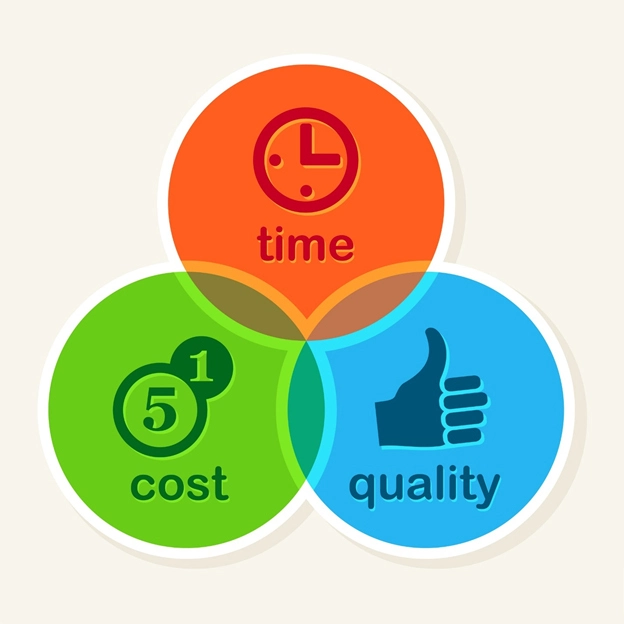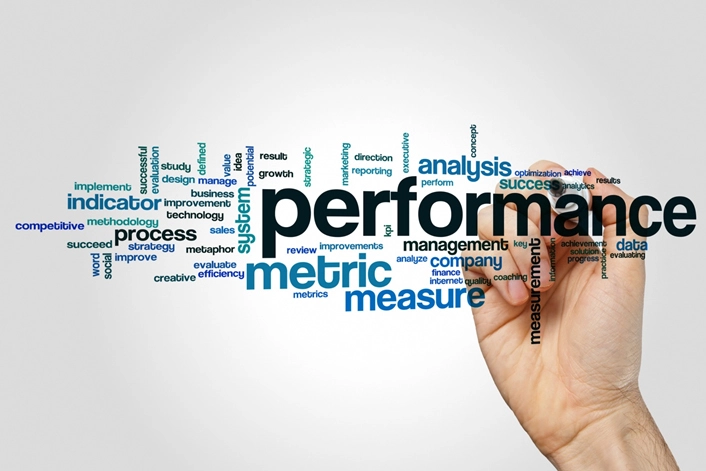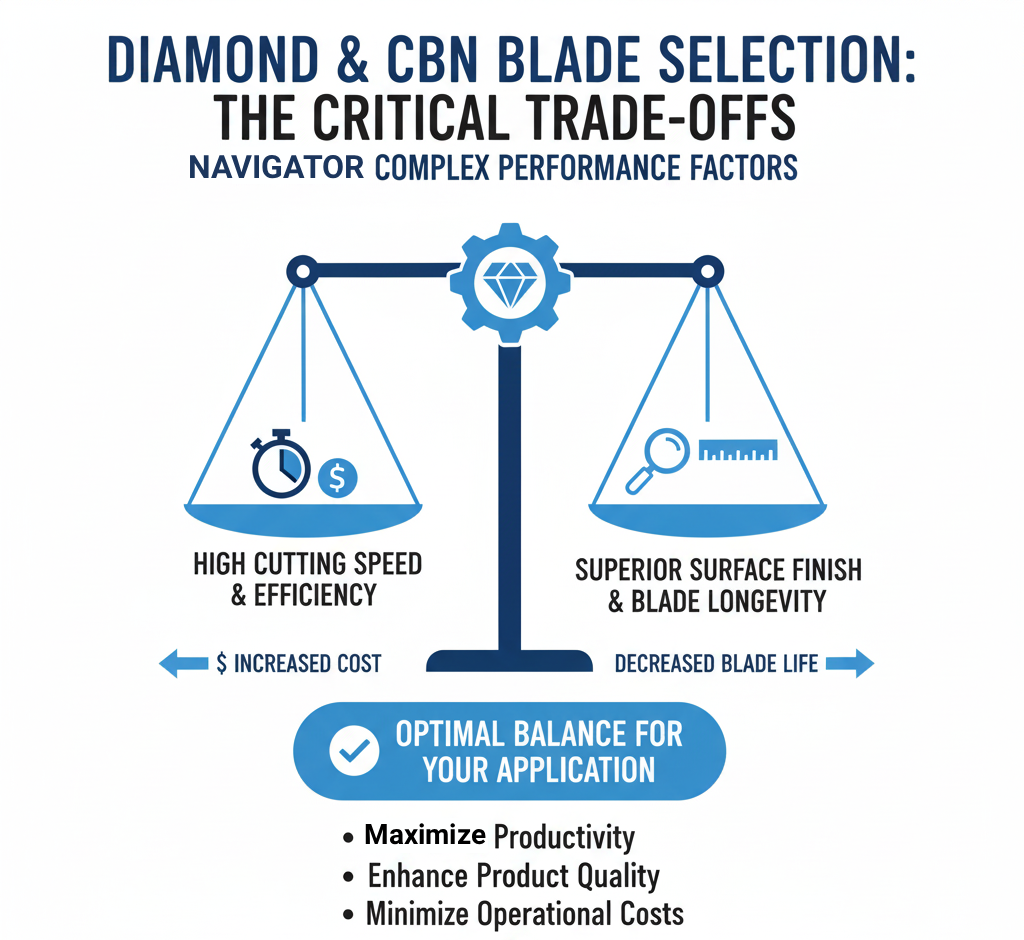Total Cost of Ownership & Why its Important
-
Posted by
 Leon Meyer
Leon Meyer
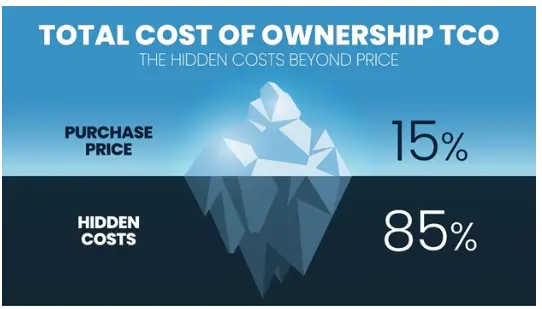
Table of Contents
ToggleDiamond and CBN cutting blades are available in a myriad of specifications, with virtually limitless options. The industry is saturated with numerous manufacturers, each professing to offer the optimal solution. However, in reality, only a select few possess the requisite expertise and experience necessary to fabricate blades that not only ensure optimal performance for each client but also deliver the most advantageous return on investment and the lowest total cost of ownership.
Many clients primarily focus on the initial purchase price when evaluating diamond and CBN blade vendors. Yet, this cost represents merely a fraction of the total expenditure associated with the blade over its operational life. A thorough understanding and evaluation of the Total Cost of Ownership (TCO) are critical. TCO includes all costs incurred from acquisition through operation to maintenance over the blade's lifespan.
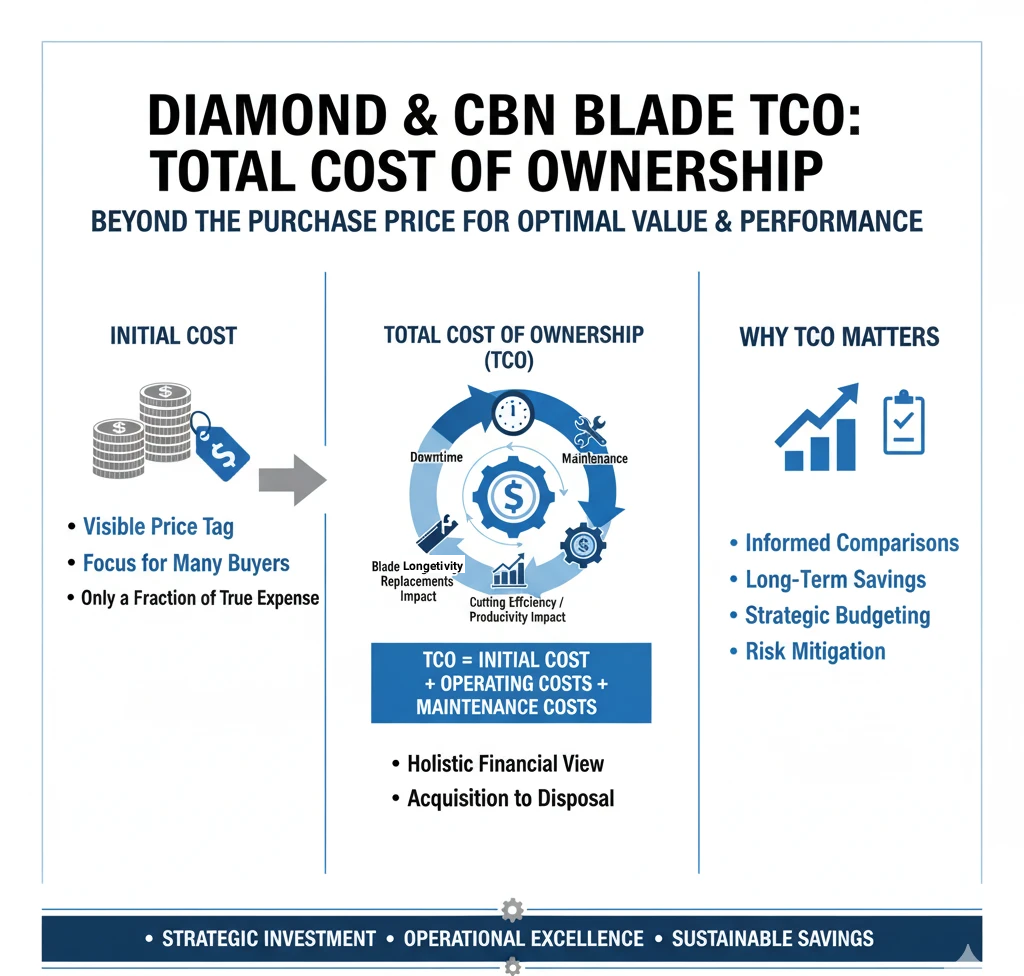
Comprehending and calculating the TCO for diamond and CBN blades is crucial for several reasons. Firstly, it provides businesses with a holistic view of the financial impact beyond the upfront cost. This encompasses factors like blade longevity, cutting efficiency, downtime, and maintenance demands. Evaluating these factors helps businesses identify the most economically viable solutions that offer the greatest value.
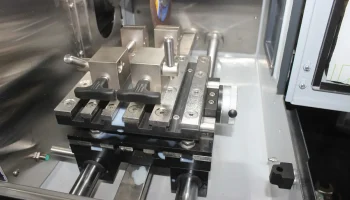
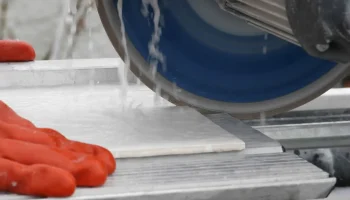
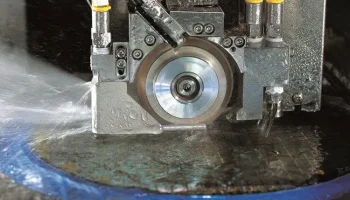
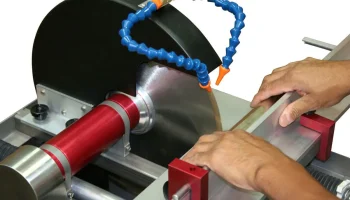
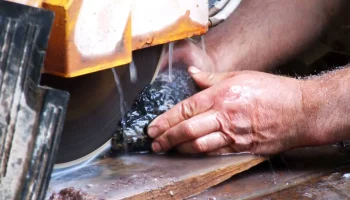
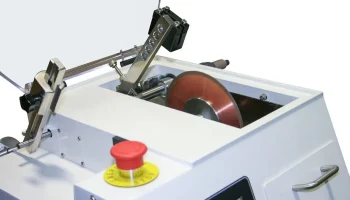
Secondly, an accurate TCO analysis facilitates the comparison of different blade options, underscoring the long-term advantages of investing in higher-quality blades. Although these may carry a higher initial price tag, they can lead to significant cost savings by reducing the frequency of replacements, minimizing downtime, and boosting productivity. This comparative analysis ensures that the selected blades meet the specific operational requirements and budgetary constraints of the company.
Furthermore, TCO calculations aid in strategic decision-making and resource allocation. Anticipating the long-term costs associated with different types of blades enables companies to better plan their budgets, optimize inventory management, and enhance overall operational efficiency. This proactive approach not only helps in controlling costs but also in mitigating the risk of unforeseen expenses that could disrupt production schedules and affect profitability.
Here is a step-by-step guide to calculating the Total Cost of Ownership (TCO) for diamond and cubic boron nitride (CBN) cutting blades, considering all relevant costs from acquisition to disposal over their entire operational lifecycle:
Initial Purchase Price
The initial purchase price of diamond and CBN blades is the most immediate and apparent cost that most people examine when comparing the products. This expense is the upfront investment required to procure the blades and is often used as a primary criterion in the decision-making process. However, focusing solely on the initial purchase price can be misleading, as it does not account for the broader financial implications associated with the blade's performance and longevity.
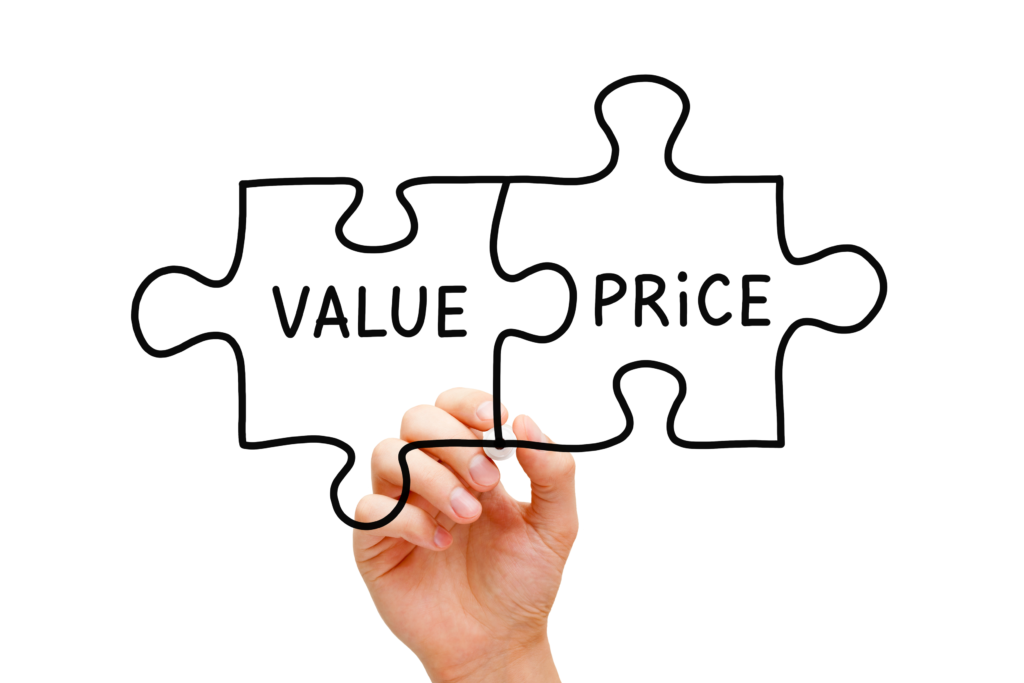
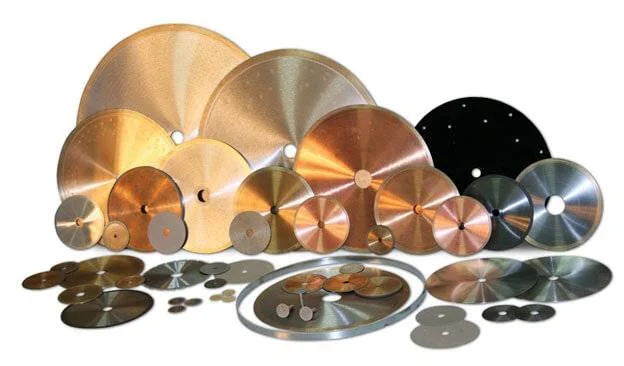
High Quality diamond and CBN blades are generally more expensive than their lower-quality counterparts. This higher upfront cost reflects the advanced manufacturing processes, proprietor bond formulations that take many decades to perfect, superior materials, and rigorous quality control measures that go into producing these blades. The use of high-grade industrial diamonds or CBN crystals ensures that the blades provide a high level of performance with precision, efficiency, and consistency
One of the primary advantages of investing in high-quality diamond and CBN blades is their extended lifespan. High Quality blades are designed to maintain their cutting edge and structural integrity over prolonged periods of use.
This durability reduces the frequency of blade replacements, leading to significant savings in procurement and operational costs. For instance, a high-quality blade that lasts twice as long as a cheaper alternative effectively halves the replacement frequency, mitigating the impact of its higher initial purchase price.
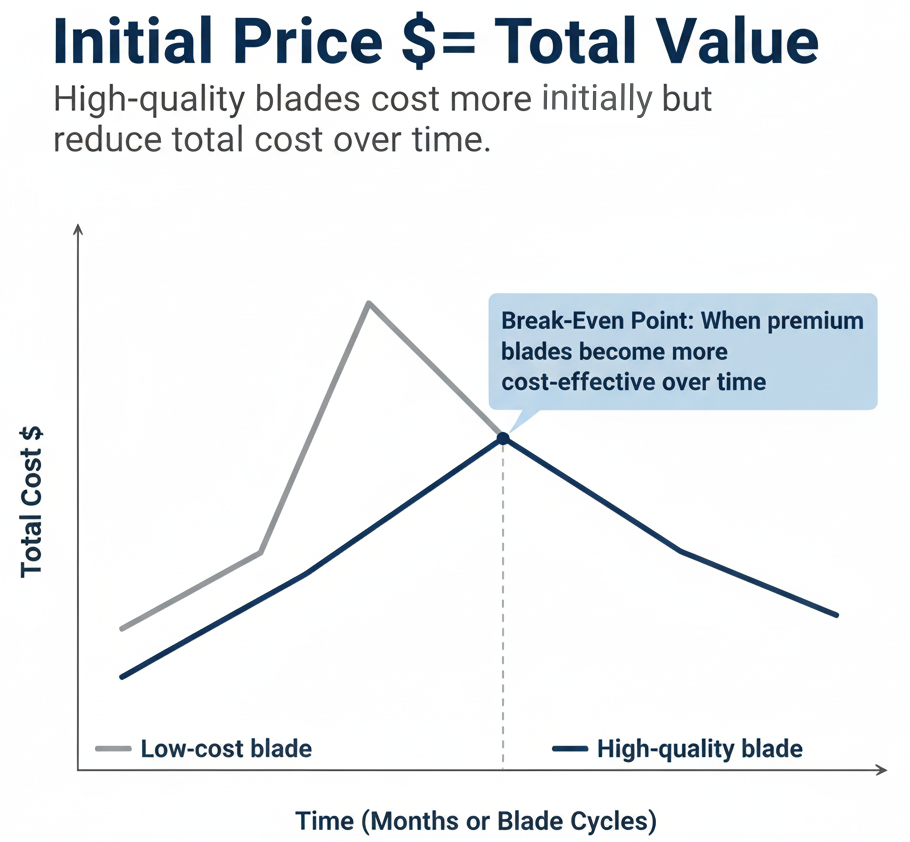
Superior performance is another critical factor that justifies the higher initial purchase price of premium diamond and CBN blades. These blades are engineered to deliver precise and efficient cutting, minimizing material wastage and improving the quality of the finished product. High-performance blades can cut through materials faster and with greater accuracy, enhancing overall productivity and reducing the time required to complete tasks. This increased efficiency can offset the initial investment by boosting output and reducing labor costs.
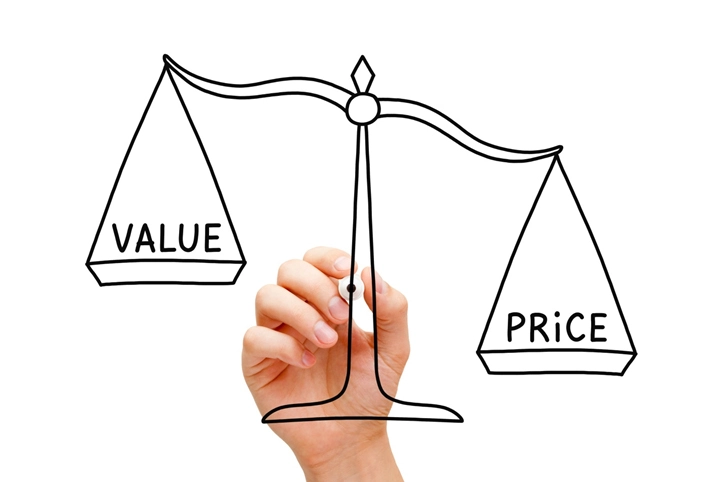
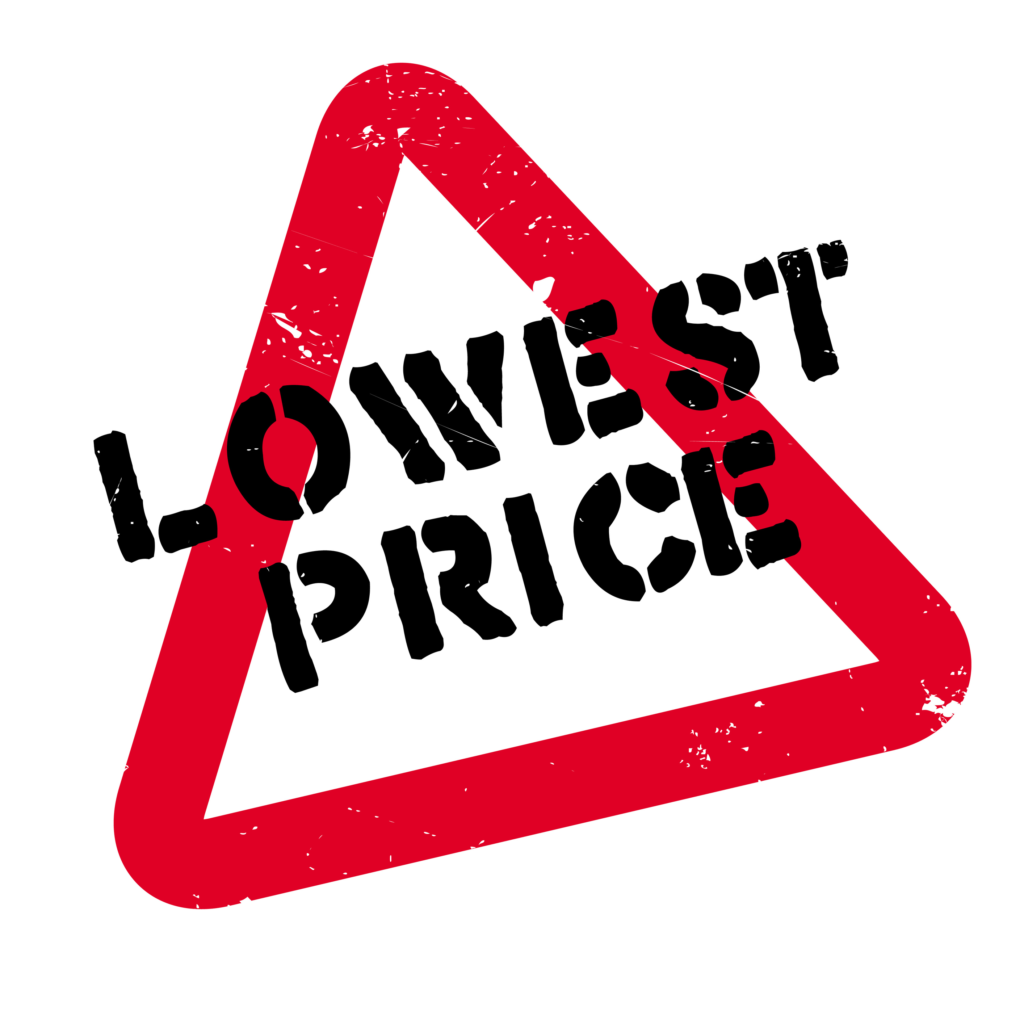
When evaluating the initial purchase price of diamond and CBN blades, it is essential to conduct a comprehensive cost-benefit analysis. This analysis should consider the blade's expected lifespan, cutting efficiency, material wastage, maintenance requirements, and operational downtime. Investing in high-quality diamond and CBN blades can lead to substantial long-term savings, even if the initial purchase price is higher. The extended lifespan and superior performance of premium blades translate into fewer replacements, reduced downtime, and lower maintenance costs. Additionally, the enhanced cutting efficiency can improve overall productivity, leading to higher output and better utilization of resources.
For clients that rely heavily on cutting operations, the initial purchase price should be viewed as a strategic investment rather than a mere expense. Selecting the right blades that offer the best combination of durability, performance, and cost-efficiency can provide a competitive advantage by optimizing operational processes and reducing overall costs. This strategic approach ensures that the business can maintain high-quality standards while managing expenses effectively.
Operating Costs
Assessing the costs related to the operation of diamond and CBN blades is a crucial step in understanding their Total Cost of Ownership. This comprehensive analysis includes energy consumption, labor costs, and the cost of consumables required for the operation.
Energy consumption refers to the cost of the energy needed to operate the cutting machinery. Efficient blades can significantly reduce energy usage by cutting through materials more quickly and with less resistance. This reduction in energy consumption not only lowers operational costs but also contributes to a more sustainable and environmentally friendly operation. Efficient cutting processes result in less energy being expended per unit of material cut, which can be particularly beneficial in large-scale or high-frequency operations where energy costs constitute a significant portion of the operational budget.
Labor costs encompass the expenses related to the manpower required to operate the blades. This includes the time spent on setup, monitoring, and adjusting the blades during operation. High-quality, efficient blades can reduce the amount of labor needed, as they tend to require less frequent adjustments and maintenance. The reduction in labor costs can be substantial, particularly in environments where skilled labor is costly or where there is a high volume of cutting tasks. By minimizing the need for constant supervision and intervention, businesses can allocate their labor resources more effectively, enhancing overall productivity.
Consumables costs cover the expenses for additional materials required to ensure the smooth operation of the blades, such as coolants, lubricants, and cleaning agents. These consumables are essential for maintaining the blade's performance and extending its lifespan. High-quality blades that operate efficiently often require fewer consumables, leading to further cost savings. Efficient blades generate less heat and friction, reducing the demand for cooling and lubrication. This not only lowers the cost of consumables but also minimizes the environmental impact of their use and disposal. Additionally, reduced wear and tear on the blades mean fewer instances of blade degradation and failure, further cutting down on the need for consumables.
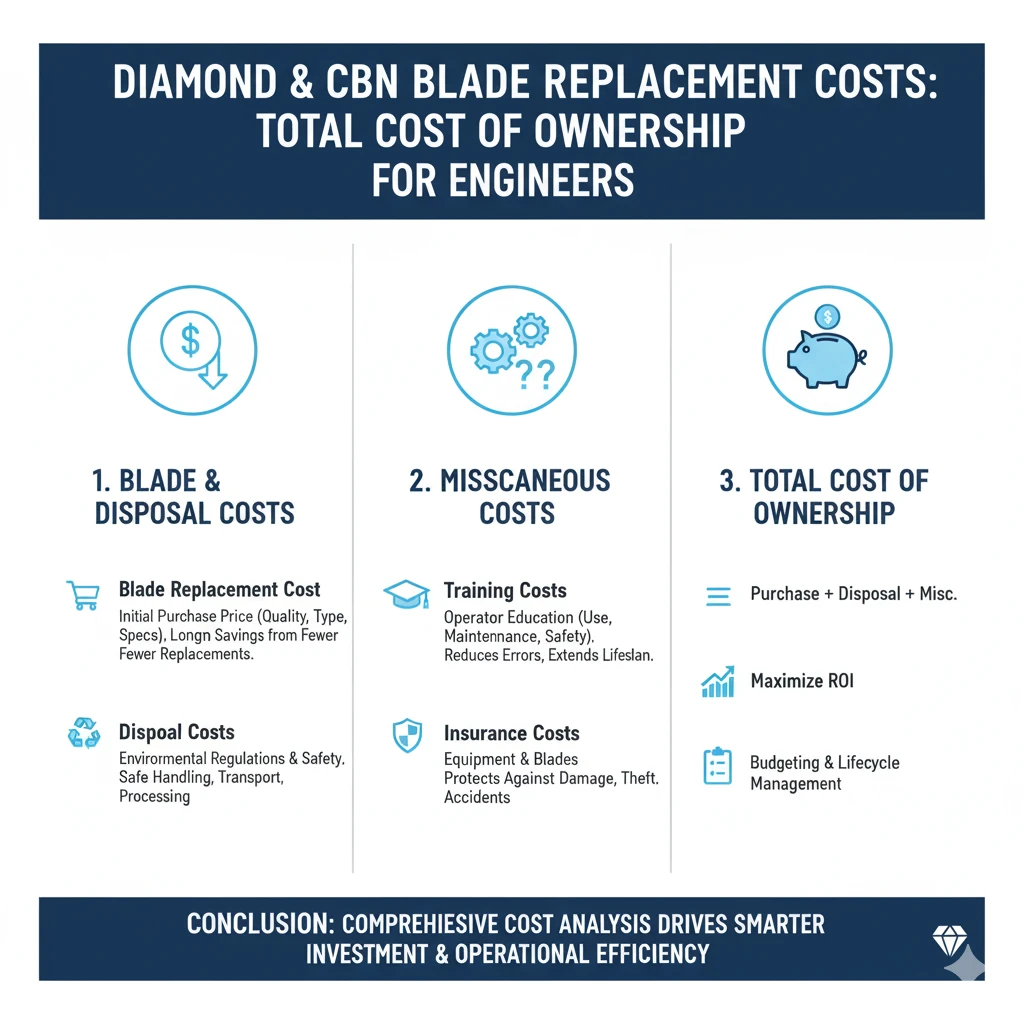
Maintenance and Repair Costs
Calculating the expenses for maintaining and repairing diamond and CBN blades is an essential step in understanding their Total Cost of Ownership. This analysis includes routine maintenance, repairs, and downtime costs.
Routine maintenance encompasses the ongoing care necessary to maintain blades in optimal working condition. This includes not only the upkeep of the blades themselves but also the repair and maintenance of the equipment on which these blades are utilized. Such maintenance is crucial for ensuring efficient performance and extending the lifespan of the blades. Typically, high-quality blades require less frequent and less intensive maintenance, which contributes to reduced overall maintenance costs.
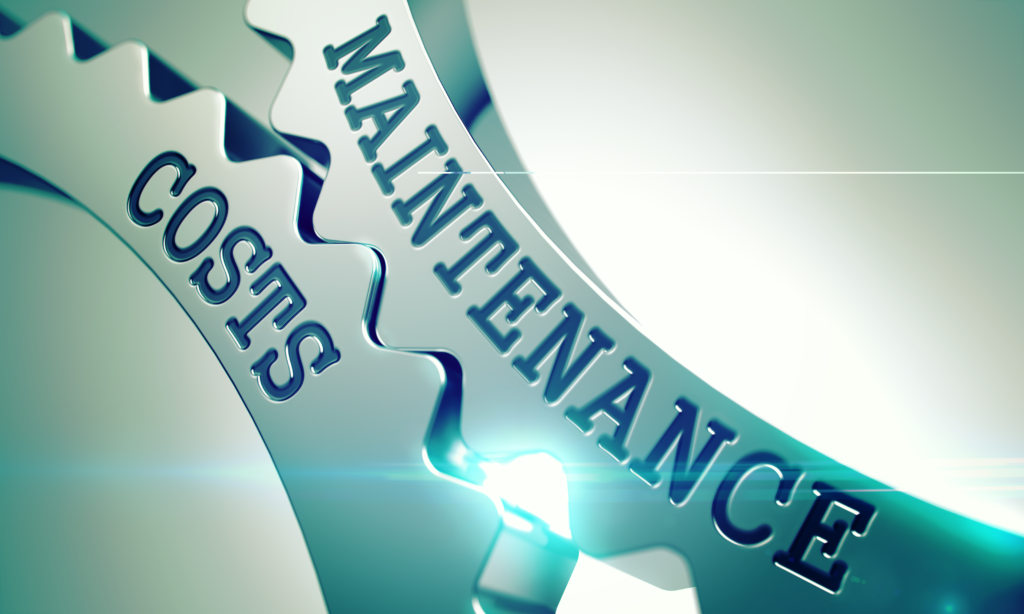
Additionally, it is vital to ensure that an adequate amount of coolant reaches the cutting zone to prevent the blades from overheating, warping, or glazing over. The correct application of coolants not only extends the life of the blade but also enhances the quality of the cut by reducing thermal stress and flushing away debris from the cutting area.
Implementing a scheduled maintenance program that includes cleaning, lubrication, and inspection can significantly prolong the operational life of both the blades and the machinery. This proactive approach ensures that all components are functioning correctly and are free from contaminants that could lead to premature wear or failure.
Adhering to consistent maintenance practices helps to prevent minor issues from developing into major complications, thereby diminishing the risk of unexpected breakdowns and ensuring continuous, efficient operation. This diligence not only safeguards the investment in the blades but also optimizes the productivity and profitability of the cutting operations.
Replacement Costs
Including the costs of replacing diamond and CBN blades when they reach the end of their usable life is a crucial step in understanding their Total Cost of Ownership. This analysis includes both the blade replacement cost and disposal costs.
Blade replacement cost refers to the expense incurred when purchasing new blades. This cost can vary significantly depending on the quality, type, and specifications of the blades required for specific cutting and grinding applications. For example, high-quality diamond and CBN blades may have a higher initial purchase price due to the use of superior materials and advanced manufacturing processes. These blades are designed to offer better performance, precision, and durability, which can extend their usable life. As a result, while the upfront cost is higher, the overall expense can be lower over time due to the reduced frequency of replacements. Therefore, it is essential to budget for these replacement costs as part of the overall lifecycle management of the blades, taking into consideration the potential long-term savings from fewer replacements.
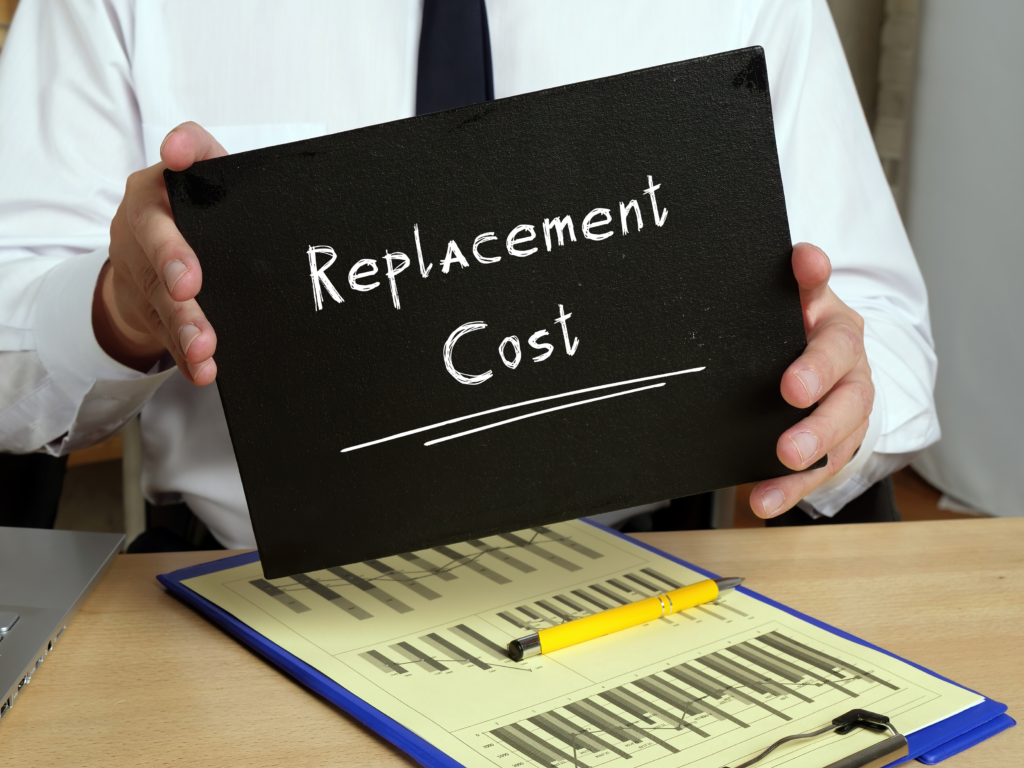
Disposal costs encompass the expenses associated with properly disposing of used blades. Industrial blade disposal must comply with environmental regulations and safety standards, which can incur additional costs. Proper disposal ensures that used blades are handled in an environmentally responsible manner, minimizing their impact on the environment. This includes considerations such as safe handling, transportation, and processing of the used blades to prevent environmental contamination and to ensure compliance with legal requirements. High-quality blades, with their longer lifespan, can reduce the frequency of disposals, thereby lowering overall disposal costs. This not only benefits the environment but also contributes to the financial efficiency of the operation by reducing recurring disposal expenses.
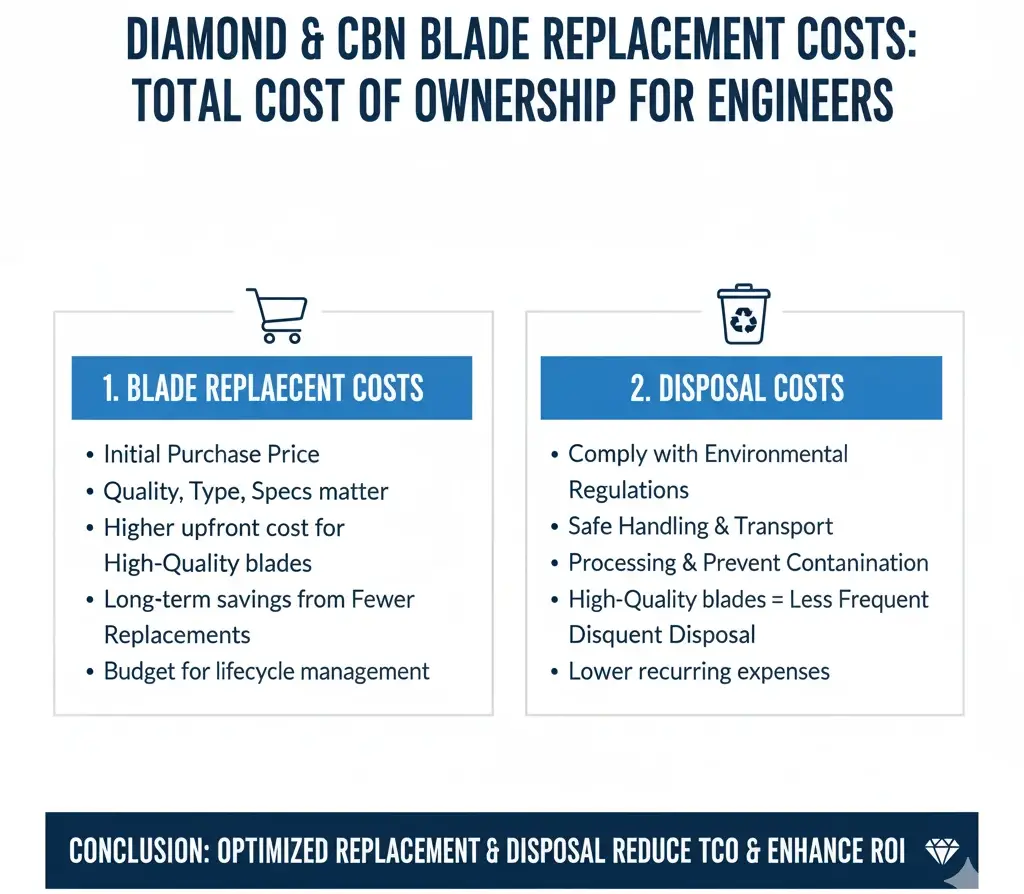
Miscellaneous Costs
Accounting for miscellaneous costs is essential to gaining a complete understanding of the Total Cost of Ownership for diamond and CBN blades. These costs can encompass various factors that might not be immediately apparent but can significantly impact overall expenses. Key miscellaneous costs include training costs and insurance costs.
Training costs refer to the expenses associated with educating operators on the proper use and maintenance of diamond and CBN blades. Effective training is crucial for maximizing blade performance and longevity. Operators need to understand the specific requirements and best practices for handling these advanced cutting tools to ensure they are used safely and efficiently. Training programs can include initial training for new operators, ongoing education to keep skills current, and specialized training for handling complex or high-precision tasks. While these training programs can represent a significant upfront expense, they can lead to long-term savings by reducing operational errors, minimizing blade damage, and extending the lifespan of the blades.

Properly trained operators are also more likely to adhere to safety protocols, reducing the risk of accidents and associated costs.
Insurance costs encompass the expenses of insuring the equipment and blades. These costs can vary depending on the value of the equipment, the operational environment, and the level of coverage required. Insuring cutting and grinding equipment is crucial to protect against potential losses due to damage, theft, or accidents. High-quality diamond and CBN blades, along with the machinery they are used with, represent a significant investment. Comprehensive insurance coverage ensures that this investment is protected, providing financial security and peace of mind. In addition to standard equipment insurance, businesses may also need to consider liability insurance, particularly if the cutting operations pose any risks to personnel or third parties. While insurance premiums are an ongoing expense, they can mitigate substantial financial losses in the event of unforeseen incidents.

Calculate Total Cost of Ownership
By summing all these costs, businesses can determine the Total Cost of Ownership for diamond and CBN blades. This comprehensive calculation ensures that all financial aspects of blade ownership are considered, enabling more informed decision-making and better financial planning. Understanding the TCO helps you optimize you investment in diamond & cbn cutting blades, cut off blade, wheels, ensuring they achieve the best balance of performance, cost-efficiency, and risk management. This holistic approach to cost assessment allows for strategic planning and resource allocation, ultimately leading to improved operational efficiency and profitability.
Sum all the costs calculated in the previous steps to determine the TCO.
Formula:
TCO = Initial Purchase Costs + Operating Costs + Maintenance and Repair Costs + Replacement Costs + Miscellaneous Costs
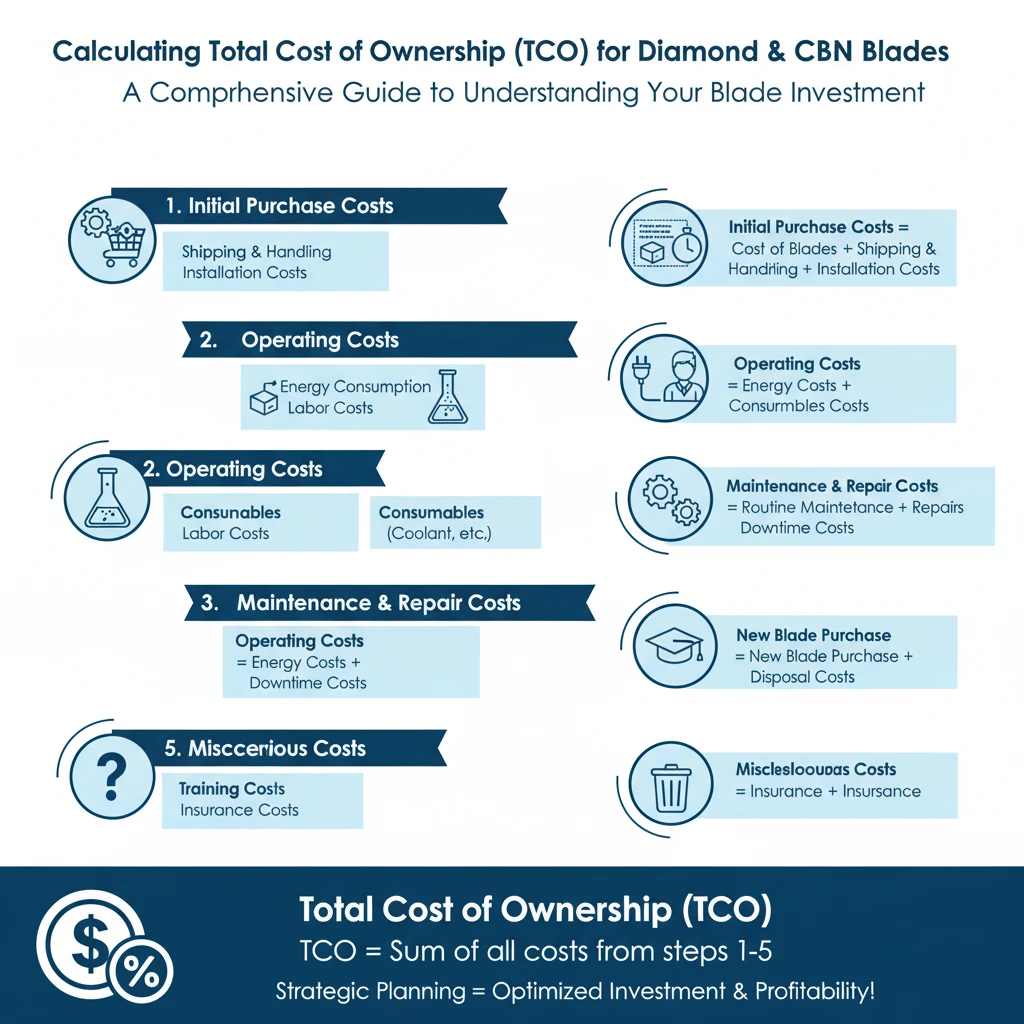
Step 1: Initial Purchase Costs
Calculate the initial costs associated with acquiring the blades.
-
 Initial Purchase Price: The cost of the blades themselves.
Initial Purchase Price: The cost of the blades themselves.
-
 Shipping and Handling: Costs associated with delivering the blades to your facility.
Shipping and Handling: Costs associated with delivering the blades to your facility.
-
 Installation Costs: Any costs incurred for setting up or installing the blades.
Installation Costs: Any costs incurred for setting up or installing the blades.
Formula:
Initial Purchase Costs=Cost of Blades+Shipping and Handling+Installation Costs.
Step 2: Operating Costs
Assess the costs related to the operation of the blades.
-
 Energy Consumption: The cost of the energy required to operate the cutting machinery.
Energy Consumption: The cost of the energy required to operate the cutting machinery.
-
 Labor Costs: The cost of labor for operating the blades, including setup and monitoring.
Labor Costs: The cost of labor for operating the blades, including setup and monitoring.
-
 Consumables: Costs of any additional consumables required for operation, such as coolants or lubricants.
Consumables: Costs of any additional consumables required for operation, such as coolants or lubricants.
Formula:
Operating Costs = Energy Costs + Labor Costs + Consumables Costs
Step 3: Maintenance and Repair Costs
Calculate the expenses for maintaining and repairing the blades.
-
 Routine Maintenance: Regular maintenance costs to keep the blades in optimal condition.
Routine Maintenance: Regular maintenance costs to keep the blades in optimal condition.
-
 Repairs: Costs associated with any necessary repairs due to wear and tear or accidental damage.
Repairs: Costs associated with any necessary repairs due to wear and tear or accidental damage.
-
 Downtime Costs: Financial impact of production downtime while blades are being maintained or repaired.
Downtime Costs: Financial impact of production downtime while blades are being maintained or repaired.
Formula:
Maintenance and Repair Costs =Routine Maintenance + Repairs + Downtime Costs
Step 4: Replacement Costs
Include the costs of replacing the blades when they reach the end of their usable life.
-
 Blade Replacement Cost: The cost of purchasing new blades.
Blade Replacement Cost: The cost of purchasing new blades.
-
 Disposal Costs: Costs associated with the disposal of used blades.
Disposal Costs: Costs associated with the disposal of used blades.
Formula:
Replacement Costs = Cost of New Blades + Disposal Costs
Step 5: Miscellaneous Costs
Account for any other costs that might be relevant.
-
 Training Costs: Expenses related to training operators to use and maintain the blades properly.
Training Costs: Expenses related to training operators to use and maintain the blades properly.
-
 Insurance Costs: Costs of insuring the equipment and blades.
Insurance Costs: Costs of insuring the equipment and blades.
Formula:
Miscellaneous Costs = Training Costs + Insurance Costs
Step 6: Calculate Total Cost of Ownership
Sum all the costs calculated in the previous steps to determine the TCO.
Formula:
TCO = Initial Purchase Costs + Operating Costs + Maintenance and Repair Costs + Replacement Costs + Miscellaneous Costs
Example # 1: cutting alumina ceramic material
calculation with a hypothetical scenario for cutting alumina ceramic material
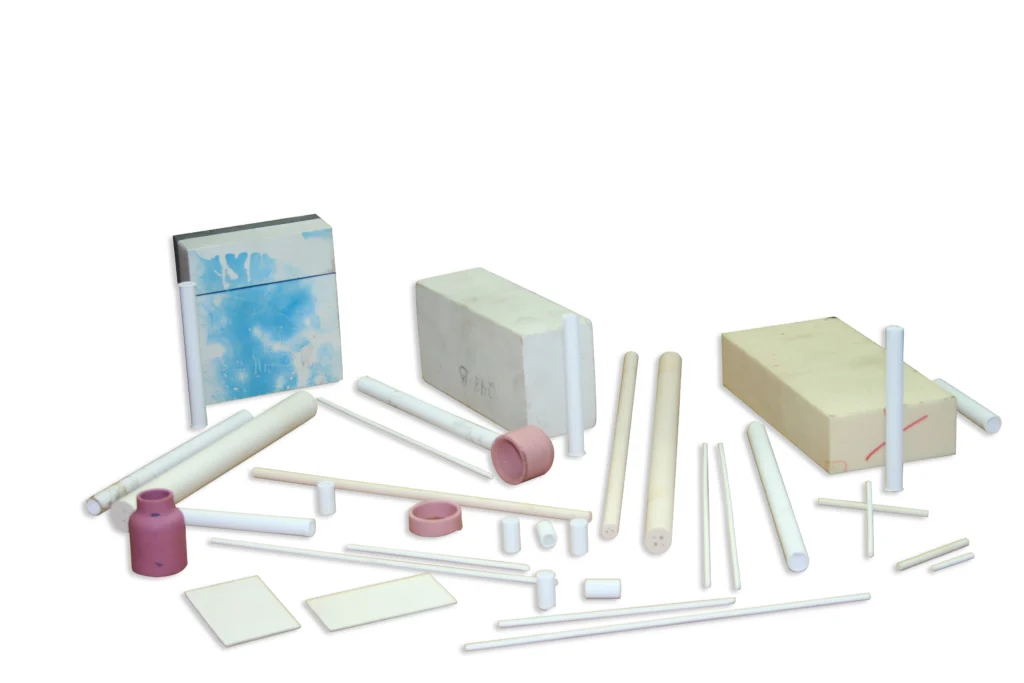
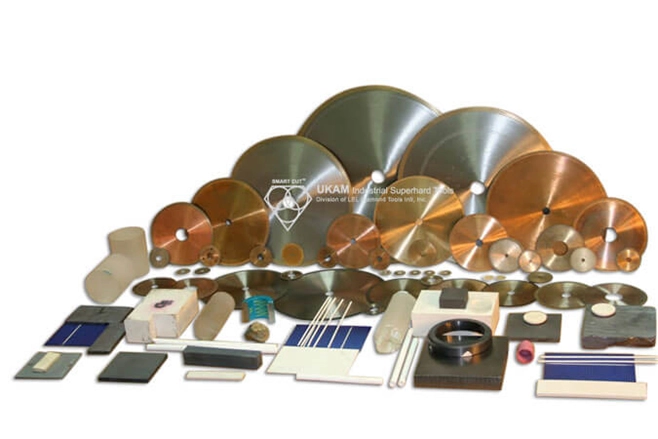
We will conduct a comparison between two diamond cut-off blades that are similar in dimensions and specifications, excluding differences in diamond concentration. Both blades measure 10 inches in diameter, 0.060 inches in thickness, and have a 1.25-inch arbor hole, with a metal bond sintered design, and a diamond height of 10mm.
10” x .060” x 1.25” diamond cut off blade, sintered (metal bond). Diamond: 10mm
-
 Blade #1 has a cost of $190 per unit.
Blade #1 has a cost of $190 per unit.
-
 Blade #2 is priced at $80 per unit.
Blade #2 is priced at $80 per unit.
At initial consideration, based purely on the cost per blade, Blade #2 appears to be the more economical option. However, a more comprehensive evaluation involving the Total Cost of Ownership (TCO) may reveal a different outcome. The TCO analysis will include factors such as the blade lifespan, frequency of replacement, operational downtime, and efficiency of cutting, which are crucial for determining the actual cost-effectiveness of each blade over its useful life. This thorough analysis aims to identify which blade truly offers the best value in terms of long-term operational costs and productivity.
|
Blade Cost |
Initial Purchase Costs |
Operating Costs (per year) |
Maintenance and Repair Costs (per year) |
Replacement Costs (per year) |
Miscellaneous Costs (per year) |
Total Annual Costs |
TCO (First Year) |
|---|---|---|---|---|---|---|---|
|
$190 |
$4100 |
$2000 |
$800 |
$4100 |
$150 |
$7050 |
$11150 |
|
$80 |
$3700 |
$3100 |
$1200 |
$3800 |
$150 |
$8250 |
$11950 |
|
Variables |
$190 Blade |
$80 Blade |
|---|---|---|
|
Initial Purchase Cost per Blade |
$190 |
$80 |
|
Number of Blades (Initial) |
20 |
40 |
|
Number of Blades (Annual Replacement) |
20 |
40 |
|
Shipping and Handling per Blade |
$10 |
$10 |
|
Installation Costs |
$100 |
$100 |
|
Energy Costs (per year) |
$500 |
$700 |
|
Labor Costs (per year) |
$1200 |
$2000 |
|
Consumables Costs (per year) |
$300 |
$400 |
|
Routine Maintenance (per year) |
$400 |
$500 |
|
Repairs (per year) |
$150 |
$300 |
|
Downtime Costs (per year) |
$250 |
$400 |
|
Training Costs (per year) |
$100 |
$100 |
|
Insurance Costs (per year) |
$50 |
$50 |
|
Disposal Costs per Blade |
$5 |
$5 |
|
Initial Purchase Costs |
$4100 |
$3700 |
|
Operating Costs (per year) |
$2000 |
$3100 |
|
Maintenance and Repair Costs (per year) |
$800 |
$1200 |
|
Replacement Costs (per year) |
$4100 |
$3800 |
|
Miscellaneous Costs (per year) |
$150 |
$150 |
|
Total Annual Costs |
$7050 |
$8250 |
|
TCO (First Year) |
$11150 |
$11950 |
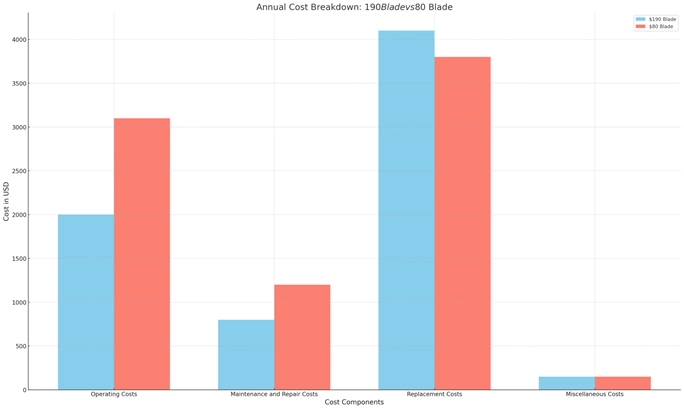
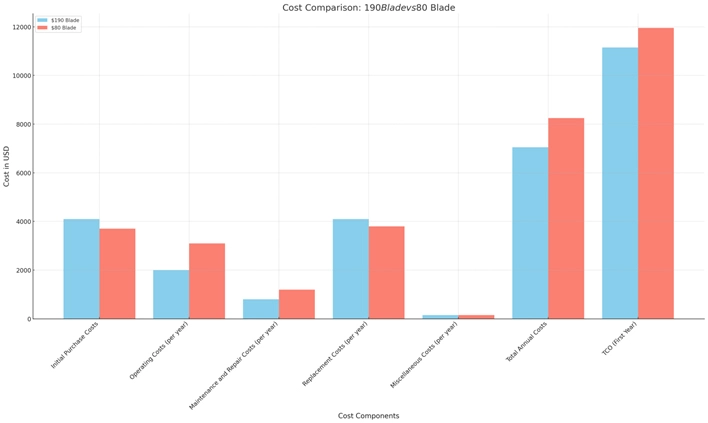
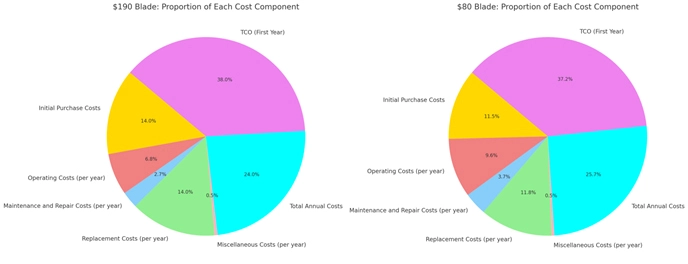
Step-by-Step Calculation – Blade # 1
-
 Initial purchase: 20 blades
Initial purchase: 20 blades
-
 Replacement: 20 blades every year
Replacement: 20 blades every year
-
 Blade cost: $190 each
Blade cost: $190 each
-
 Additional shipping and handling per blade: $10
Additional shipping and handling per blade: $10
-
 Installation costs (initial setup): $100
Installation costs (initial setup): $100
-
 Energy costs per year: $500
Energy costs per year: $500
-
 Labor costs per year: $1,200
Labor costs per year: $1,200
-
 Consumables costs per year: $300
Consumables costs per year: $300
-
 Routine maintenance per year: $400
Routine maintenance per year: $400
-
 Repairs per year: $150
Repairs per year: $150
-
 Downtime costs per year: $250
Downtime costs per year: $250
-
 Training costs per year: $100
Training costs per year: $100
-
 Insurance costs per year: $50
Insurance costs per year: $50
-
 Disposal costs per blade: $5
Disposal costs per blade: $5
Step 1: Initial Purchase Costs
Calculate the initial costs associated with acquiring the blades. Initial Purchase Cost of Blades=20×$190=$3,800
Shipping and Handling = 20 × $10 = $200
Installation Costs = $100
Initial Purchase Costs = $3,800 + $200 + $100 = $4,100
Step 2: Operating Costs
Assess the costs related to the operation of the blades. Operating Costs (per year)= $500 + $1,200 + $300 = $2,000
Step 3: Maintenance and Repair Costs
Calculate the expenses for maintaining and repairing the blades. Maintenance and Repair Costs (per year) = $400 + $150 + $250 = $800
Step 4: Replacement Costs
Include the costs of replacing the blades when they reach the end of their usable life.
-
 Replacement Cost of Blades (every year): 20 × $190 = $3,800
Replacement Cost of Blades (every year): 20 × $190 = $3,800
-
 Shipping and Handling for Replacements (every year): 20 × $10 = $200
Shipping and Handling for Replacements (every year): 20 × $10 = $200
-
 Disposal Costs (every year): 20 × $5 = $100
Disposal Costs (every year): 20 × $5 = $100
Replacement Costs (per year): $3,800 + $200 + $100 = $4,100
Step 5: Miscellaneous Costs
Account for any other costs that might be relevant.
-
 Training Costs per year: $100
Training Costs per year: $100
-
 Insurance Costs per year: $50
Insurance Costs per year: $50
Miscellaneous Costs (per year): $100 + $50 = $150
Sum all the costs calculated in the previous steps to determine the TCO.
-
 Total Annual Costs = Operating Costs + Maintenance and Repair Costs + Replacement Costs + Miscellaneous Costs
Total Annual Costs = Operating Costs + Maintenance and Repair Costs + Replacement Costs + Miscellaneous Costs
-
 Total Annual Costs: $2,000 + $800 + $4,100 + $150 = $7,050
Total Annual Costs: $2,000 + $800 + $4,100 + $150 = $7,050
Total Cost of Ownership (for the first year)
TCO (First Year) = Initial Purchase Costs + Total Annual Costs
-
 TCO (First Year): $4,100 + $7,050 = $11,150
TCO (First Year): $4,100 + $7,050 = $11,150
Therefore, the Total Cost of Ownership for the first year, considering all the costs associated with the blades, is $11,150.
Blade # 1 – Total Cost Of Ownership Calculation
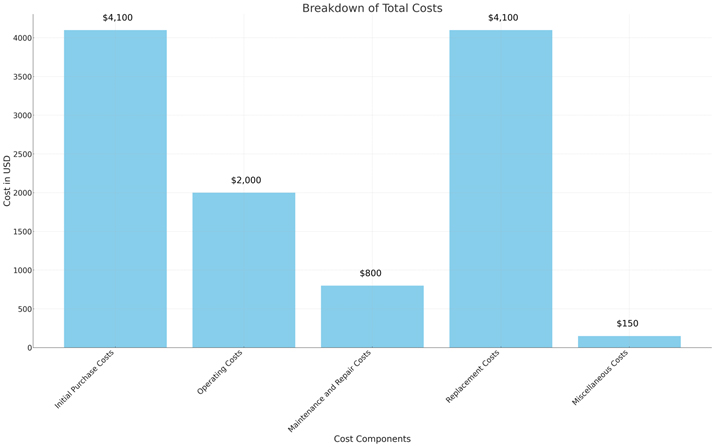
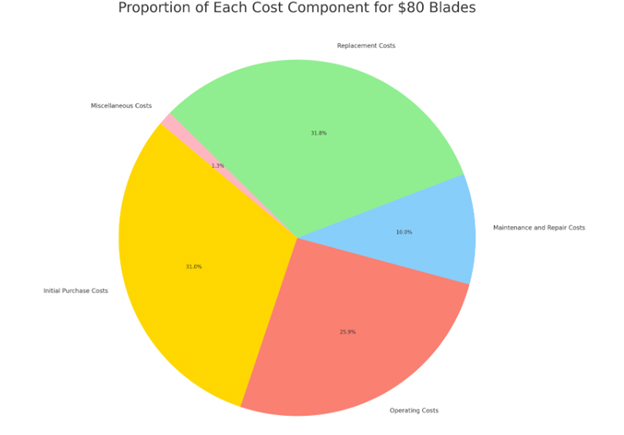
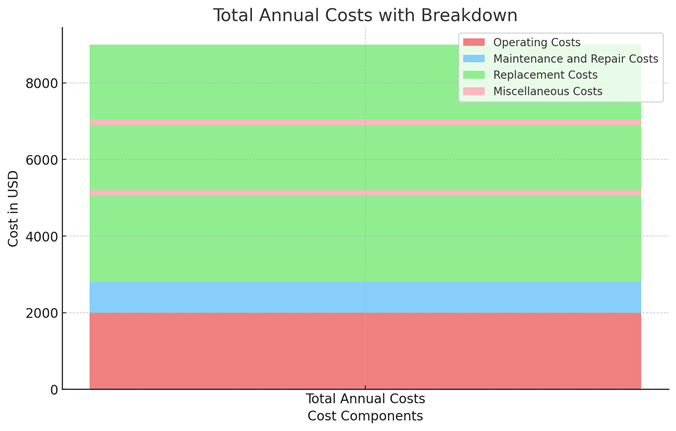
Same Cenario using Blade # 2
-
 Blade cost: $80 each
Blade cost: $80 each
-
 Initial purchase: 40 blades (due to shorter lifespan)
Initial purchase: 40 blades (due to shorter lifespan)
-
 Replacement: 40 blades every year
Replacement: 40 blades every year
-
 Additional shipping and handling per blade: $10
Additional shipping and handling per blade: $10
-
 Installation costs (initial setup): $100
Installation costs (initial setup): $100
-
 Energy costs per year: $700 (higher due to longer cutting time)
Energy costs per year: $700 (higher due to longer cutting time)
-
 Labor costs per year: $2,000 (higher due to longer cutting time)
Labor costs per year: $2,000 (higher due to longer cutting time)
-
 Consumables costs per year: $400 (higher due to increased wear)
Consumables costs per year: $400 (higher due to increased wear)
-
 Routine maintenance per year: $500 (higher due to increased wear)
Routine maintenance per year: $500 (higher due to increased wear)
-
 Repairs per year: $300 (higher due to increased wear)
Repairs per year: $300 (higher due to increased wear)
-
 Downtime costs per year: $400 (higher due to increased maintenance and repairs)
Downtime costs per year: $400 (higher due to increased maintenance and repairs)
-
 Training costs per year: $100
Training costs per year: $100
-
 Insurance costs per year: $50
Insurance costs per year: $50
-
 Disposal costs per blade: $5
Disposal costs per blade: $5
Step-by-Step Calculation
Step 1: Initial Purchase Costs
Calculate the initial costs associated with acquiring the blades.
-
 Initial Purchase Cost of Blades: 40 x $80 = $3,200
Initial Purchase Cost of Blades: 40 x $80 = $3,200
-
 Shipping and Handling: 40 x $10 = $400
Shipping and Handling: 40 x $10 = $400
-
 Installation Costs: $100
Installation Costs: $100
Initial Purchase Costs: $3,200 + $400 + $100 = $3,700
Step 2: Operating Costs
Assess the costs related to the operation of the blades.
Operating Costs (per year): $700 + $2,000 + $400 = $3,100
Step 3: Maintenance and Repair Costs
Calculate the expenses for maintaining and repairing the blades.
-
 Routine Maintenance per year: $500
Routine Maintenance per year: $500
-
 Repairs per year: $300
Repairs per year: $300
-
 Downtime Costs per year: $400
Downtime Costs per year: $400
Maintenance and Repair Costs (per year): $500 + $300 + $400 = $1,200
Step 4: Replacement Costs
Include the costs of replacing the blades when they reach the end of their usable life.
-
 Replacement Cost of Blades (every year): 40 x $80 = $3,200
Replacement Cost of Blades (every year): 40 x $80 = $3,200
-
 Shipping and Handling for Replacements (every year): 40 x $10 = $400
Shipping and Handling for Replacements (every year): 40 x $10 = $400
-
 Disposal Costs (every year): 40 x $5 = $200
Disposal Costs (every year): 40 x $5 = $200
Replacement Costs (per year): $3,200 + $400 + $200 = $3,800
Step 5: Miscellaneous Costs
Account for any other costs that might be relevant.
-
 Training Costs per year: $100
Training Costs per year: $100
-
 Insurance Costs per year: $50
Insurance Costs per year: $50
Miscellaneous Costs (per year): $100 + $50 = $150
Step 6: Calculate Total Cost of Ownership
Sum all the costs calculated in the previous steps to determine the TCO.
-
 Total Annual Costs = Operating Costs + Maintenance and Repair Costs + Replacement Costs + Miscellaneous Costs
Total Annual Costs = Operating Costs + Maintenance and Repair Costs + Replacement Costs + Miscellaneous Costs
-
 Total Annual Costs: $3,100 + $1,200 + $3,800 + $150 = $8,250
Total Annual Costs: $3,100 + $1,200 + $3,800 + $150 = $8,250
Total Cost of Ownership (for the first year)
TCO (First Year) = Initial Purchase Costs + Total Annual Costs
-
 TCO (First Year): $3,700 + $8,250 = $11,950
TCO (First Year): $3,700 + $8,250 = $11,950
Therefore, the Total Cost of Ownership for the first year, considering all the costs associated with the cheaper blades, is $11,950, which is higher than the TCO for the more expensive $190 blades ($11,150).
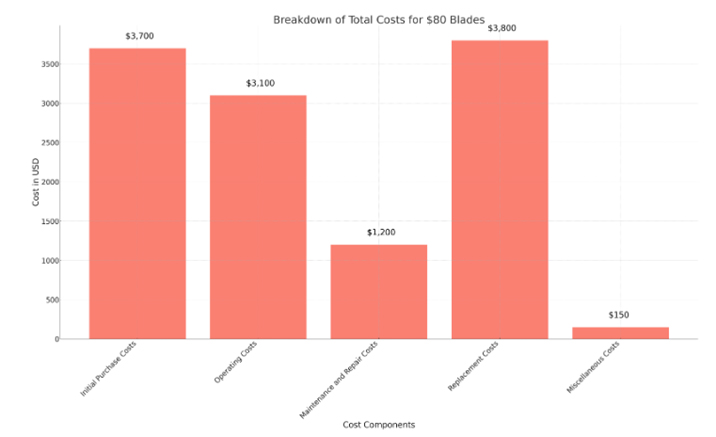
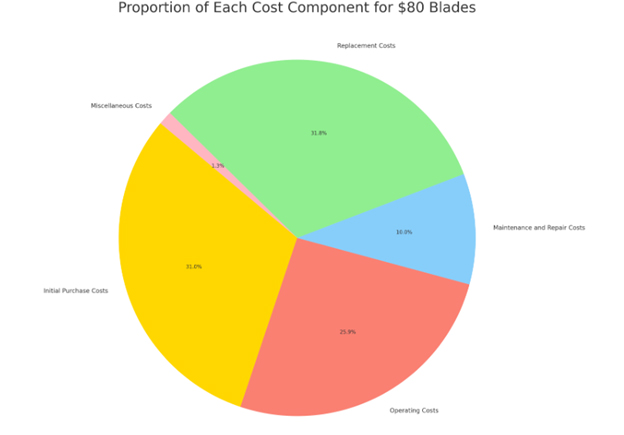
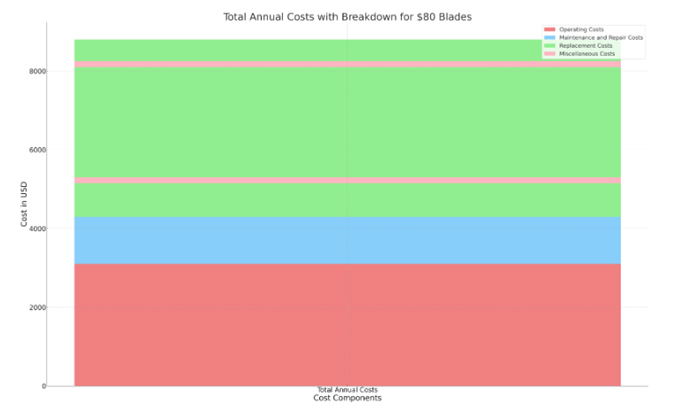
-
 Energy Costs per year: $700
Energy Costs per year: $700
-
 Labor Costs per year: $2,000
Labor Costs per year: $2,000
-
 Consumables Costs per year: $400
Consumables Costs per year: $400

Leon Meyer is a veteran manufacturing engineer and technical consultant with over 50 years of experience in the development, implementation, and troubleshooting of industrial diamond tooling systems. Having spent his career at the intersection of tool design, precision manufacturing, and production engineering, Mr. Meyer is widely regarded as one of the most experienced voices in the application of ultra-thin diamond blades, sintered core drills, and CBN grinding wheels across heavy industry, advanced materials, and research sectors.
Known for his pragmatic, no-nonsense approach, Leon has advised manufacturers across the United States, Europe, and East Asia—helping streamline cutting processes, extend tool life, and solve complex issues related to material breakage, chipping, and tolerance drift. His expertise has directly contributed to improved production efficiency in industries ranging from aerospace alloys and technical ceramics to optics, composites, and high-nickel superalloys.
As an author, Mr. Meyer brings a lifetime of field knowledge to his writing, with a focus on real-world problem solving, cost-performance optimization, and tool reliability under demanding conditions.
ARE YOU USING RIGHT DIAMOND & CBN BLADES
FOR YOUR APPLICATION?
LET US
HELP YOU
HAVING ISSUES WITH
YOUR CURRENT DIAMOND & CBN BLADES?
Knowledge Center
Select right Diamond Blade for your application
How to Properly Use Precision Diamond & CBN Blades
Precision & Ultra Thin Diamond Blade Guide
How to Improve & Optimize Your Diamond Sawing Operation
Evaluating & Comparing Diamond Blades
Top 5 Diamond & CBN Cutting Blade Performance Metrics
Diamond & CBN Cutting Blade Performance Metrics that you Should Know
Understanding Tradeoffs- Searching for Perfect Diamond & CBN Blade

Leon Meyer is a veteran manufacturing engineer and technical consultant with over 50 years of experience in the development, implementation, and troubleshooting of industrial diamond tooling systems. Having spent his career at the intersection of tool design, precision manufacturing, and production engineering, Mr. Meyer is widely regarded as one of the most experienced voices in the application of ultra-thin diamond blades, sintered core drills, and CBN grinding wheels across heavy industry, advanced materials, and research sectors.
Known for his pragmatic, no-nonsense approach, Leon has advised manufacturers across the United States, Europe, and East Asia—helping streamline cutting processes, extend tool life, and solve complex issues related to material breakage, chipping, and tolerance drift. His expertise has directly contributed to improved production efficiency in industries ranging from aerospace alloys and technical ceramics to optics, composites, and high-nickel superalloys.
As an author, Mr. Meyer brings a lifetime of field knowledge to his writing, with a focus on real-world problem solving, cost-performance optimization, and tool reliability under demanding conditions.



















































